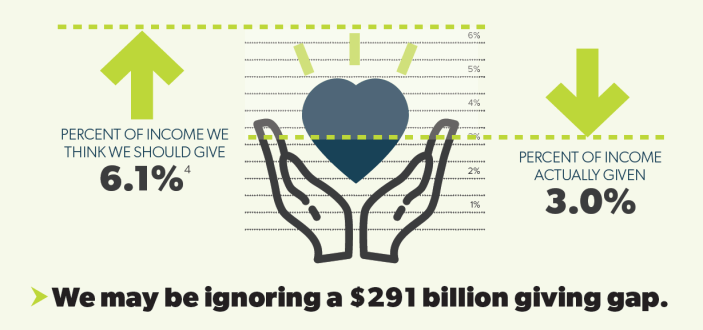It’s often said that Americans are exceptionally generous, and fortunately, it’s a claim that’s well supported by the numbers. In 2016 alone, U.S. households donated over $282 billion to charities worldwide. And when compared globally, the U.S. consistently ranks as one of the most altruistic countries by the World Giving Index. But do these absolute figures and relative rankings capture the full nature of generosity in America?
At ideas42, we’ve been examining how and why people donate. What we’ve seen is that giving is often reactive and based on an emotional response to a prompt or specific solicitation. In many ways, this approach is helpful in ensuring that we’re addressing urgent needs as they arise, but it also leaves people with an unclear sense of their giving overall. As we know from studying behavior, lack of planning and salience can prevent people from following through on their intentions.
To see whether people’s actions are matching their true philanthropic intentions, we conducted a simple survey in which we asked people how much they thought their neighbors should donate to charity. Surprisingly, the average respondent said their peers should give about 6% of their income annually – more than double what people actually donate each year! The implication of this mismatch is clear. Many Americans are likely giving less on average than we ourselves believe we should.
If we can help people be more deliberate and thoughtful about their giving, we could unlock billions of dollars for important causes. Over the past two years, we’ve been working on doing just that. With the support of the Bill & Melinda Gates Foundation, we’ve been designing and implementing behavioral solutions that aim to encourage Americans to be more generous, intentional, and informed in their giving.
The insights we’ve gathered to date are captured in our new report, Best of Intentions, which expands on the importance of thoughtful giving to donors and charities alike. It also spotlights four behavioral interventions that demonstrate how practitioners working in the philanthropic field can help donors be better aligned with their giving goals. Through these projects, we show innovative ways to:
- Increase the overall generosity of Donor-Advised Fund clients by activating their donor identities through a year-end-review of their giving activity.
- Encourage more employees to donate through their workplace giving program by reframing incentives as opportunities they should not lose.
- Help individuals reach higher levels of philanthropy by offering goal-setting tools that lead them to be more thoughtful about their donations.
- Promote more informed giving by presenting curated lists of charities to donors to help them more effectively and efficiently support the causes they care about.
These findings are just the start of our exploration into donor behavior. We will continue to identify areas of the giving context that may limit how well and how much people give. And ultimately, we will seek more innovative ways to overcome these barriers, helping people close the gap between their intended generosity and their actual donations.
Best of Intentions not only provides groundwork for future efforts—it is also a useful guide right now for practitioners seeking new strategies for improving charitable giving. Applying proven solutions to new contexts can help more Americans follow through on their generous intentions and equip charitable organizations with resources they need to improve lives.



